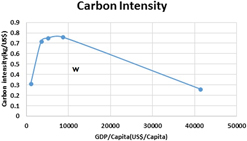Published online by Cambridge University Press: 27 May 2019

This article will show that within well-defined error margins, carbon intensities and energy intensities are independent of the population and GDP of countries and thus can serve as a convenient parametrization of humanity on a sovereign level.
The IPCC, in its fifth international report, states that the two leading contributions to changes in annual CO2 emissions by decade are the changes in population and changes in GDP/capita, which reflect changes in standard of living. This article will show that within well-defined error margins, carbon intensities, and energy intensities (both with respect to GDP) are independent of the population and GDP of countries and thus can serve as a convenient parametrization of humanity. With some imagination, these parameters can serve as input and output indicators that connect the physical environment with the human environment. The article will show that both indicators fit lognormal distribution well without any outliers. The data are based on the World Bank database. Comparing the global distribution with individual world-bank indicators of world-bank country grouping based on socioeconomic conditions quantifies the contributions of global income distribution.
Please note an has been issued for this article.